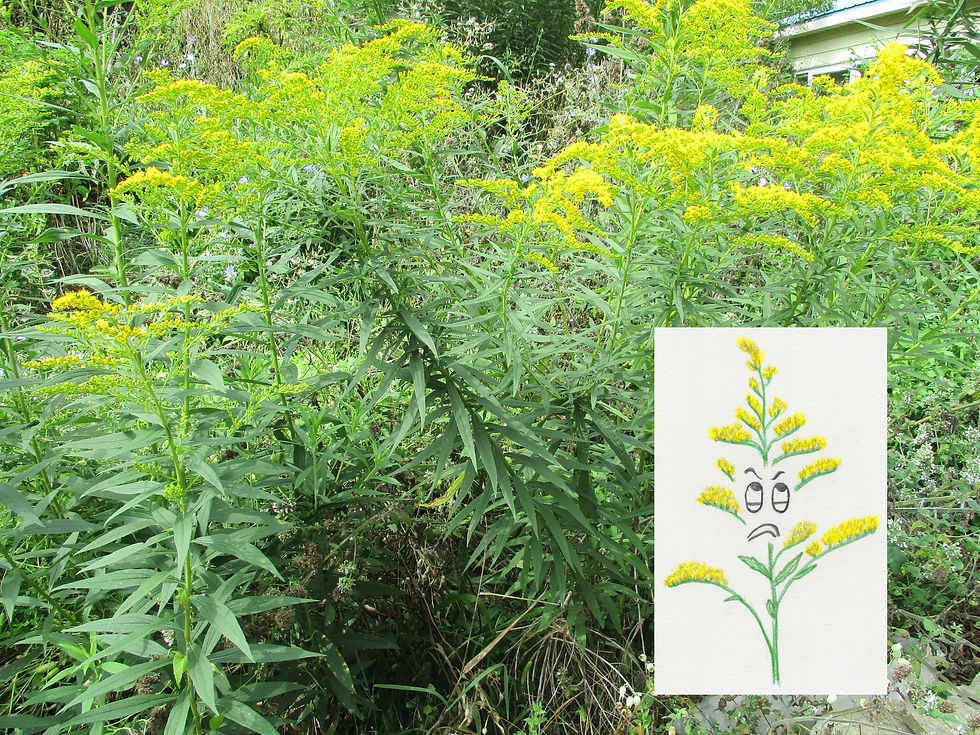Canada Goldenrod
Given Name: Solidago canadensis
Nicknames: tall goldenrod, common goldenrod, meadow goldenrod, rock goldenrod, rough goldenrod, Hager's goldenrod, shorthair goldenrod
Family: Asteraeae (Daisy/Aster)

*sigh*
I suppose I should talk to you.
Do you even know who I am?
Probably not.
I hope that you at least recognize me as goldenrod- that's pretty obvious from my clusters of tiny yellow flowers. But that's not enough: there are 32 species of goldenrod native to Canada and over 75 species worldwide.
I can't believe you haven't taken the time to get to know me personally since I'm a plant that you see all the time in moist or dry fields and meadows, edges of forests, swamps, clearings, orchards and compost piles, and along roadsides, ponds, streams, fencerows and shorelines (shall I keep listing places or have you gotten the idea that I'm found almost everywhere?).
I grow 4- 5 feet tall (so it's not like I'm easy to miss) with branching pyramid-shaped cascading clusters of blossoms from late August until October (again, not subtle!). My alternate, lance-shaped, sharply-toothed leaves are hairy on the bottom and clasp my hairy central stems. I spread by seed and by creeping rhizomes...
What?
You think I'm too pushy with my seedy and rhizominous growth habits?
Really? You're calling me an invasive plant in my own native range of North America? That's rich!
Have you looked at your population's growth habits lately? Ummm yeah... it's like the pot calling the kettle black. At least I provide benefits for the ecosystems I join. In North America, I host hundreds of different insect species, providing shelter or food to bees, butterflies, spiders, praying mantises and many others.
But what about Europe? You ask.
What about Europe?
What are you saying?
Are you blaming me for being invasive there?
Well, no kidding! Of course I became a problem in Europe. Did you really expect me to behave differently just because I was on vacation? This one is on you, people... you knew my habits and yet you introduced me there in 1645. And people didn't even learn from that! I was brought to China in 1930 and who knows what I'm doing there now.
Oh! Gesundheit! Do you have allergies?
Geeze...no way! Not again! Why do people always try to pin their hay-fever on me?
I'm getting tired of explaining this every time I talk to someone. Well, I'm only going to say this once, so listen carefully:
I am not responsible for your allergies.
I'm not saying I wouldn't enjoy giving you the sniffles every once in a while. But I can't. I am physically incapable of making you sneeze. My pollen is designed for being carried by insects which makes it too heavy to be blown up your nose. It's actually my pal ragweed that gets to play that little joke on you.
No, not a funny joke? I guess it's all a matter of perspective.
Anyway, now that all that is finally cleared up, can we get on with talking about some of the good things I do for people?
Ummmm... yeah! I do help...
...I'm just not sure why, considering all the shade you cast (I much prefer full sun). But I guess when my family's been helping people for millennia, it just becomes habit. My cousins were used as far back as Ancient Egypt and more recently many First Nations people referred to me as “Sun Medicine” (because of my bright colour and healing properties). Oh, you didn't realize I was a healing plant?
Obviously I'm medicinal! Duh!
With a name like Solidago, which is Latin for “to make whole again”, what else would you think? Traditionally I've been used to treat wounds, allergies, TB, arthritis, asthma, hypertension and as a diuretic.
I happen to be edible too. Don't be surprised! Lots of perennials are, including Turkish rocket, ground elder, garlic mustard, sweet cicely and wintercress. The real question is: do I taste good? But if you've never taken the time to eat my tender tips and tops in early summer (just blanch me for a minute or two in salted water), why should I tell you? Okay... fine.... if you insist (you're so demanding!): I have a rather a strong flavour that reminds some people of celery. There, you happy?
Now you can avoid me because I might offend your delicate palate.
Arg! I don't even know why I bother talking to people. Everyone already has their mind made up about me. It's not like if you learn that I'm the official state flower of South Carolina (since 2003!), you're going to change your opinion of me. I might as well just to go back to feeding the sheep, cattle, horses and deer and accumulating nutrients in the soil. It's far less frustrating!
I'm outa here,
Exasperated Canada Goldenrod
References:
Bergo, A. (n.d.). “Goldenrod Shoots ad Tips”. Forager Chef. https://foragerchef.com/goldenrod-shoots-and-tips/
Crawford, M. (2010). Creating a Forest Garden: Working with nature to grow edible crops. Cambridge: Green Books Ltd., pp 253.
Ho, W. (2021). “A Case of Mistaken Identity: Goldenrod and Ragweed”. Nature Conservancy of Canada. https://www.natureconservancy.ca/en/blog/goldenrod-versus-ragweed.html#.YWYWYhwpBPY
"Plant Fact Sheet: Canada Goldenrod” (n.d.). United States Department of Agriculture and natural Resources conservation Services. https://www.nrcs.usda.gov/Internet/FSE_PLANTMATERIALS/publications/wapmcfs11193.pdf
Smith, B.H. (2018, September 10). “How to Tell the Difference Between Goldenrod and Ragweed”. Clemson Cooperative Extension. https://hgic.clemson.edu/how-to-tell-the-difference-between-goldenrod-and-ragweed/
"Solidago canadensis” (n.d.). Missouri Botanical Garden. https://www.missouribotanicalgarden.org/PlantFinder/PlantFinderDetails.aspx?taxonid=277473
"Solidago canadensis” (n.d.). North Carolina State Extension. https://plants.ces.ncsu.edu/plants/solidago-canadensis/
Williamson, J. (2021, August 20). “Goldenrod and Ragweed”. Clemson Cooperative Extension. https://hgic.clemson.edu/factsheet/goldenrod-ragweed/
Oh, lovely story. Keep going and thank you!
nice